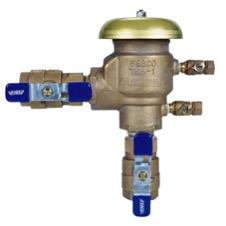Backflow Prevention and Cross Connection are terms related to the possible contamination of drinking water when water connections cross and contaminants flow from untreated or contaminated water into clean, potable water. To prevent pollutants and contaminants from entering LTWD's water system, backflow assemblies are required on sprinkler & irrigation systems.
As a public water provider, LTWD is responsible for overseeing prevention of water contamination from cross connections in the water distribution system. LTWD has adopted the Colorado Cross-Connection Control Manual, 5th Edition, as standards for its Backflow Prevention/Cross Connection Control Program.
Property Owner Responsibilities
Under Colorado Primary Drinking Water Regulations (5 CCR 1002-11), Sections 11.37 and 11.39:
LTWD is required to survey all non-single-family-residential connections to the public water system to determine if the connection is a cross connection unless the supplier controls that connection with the most protective backflow prevention assembly or backflow prevention method. The supplier must survey all connections within the supplier's waterworks to determine if the connection is a cross connection.
If LTWD becomes aware of a single-family-residential connection to the public water system that is a cross connection, the supplier must determine the type of backflow prevention assembly or backflow prevention method to control the cross connection.
Non-residential property owners and single family residential customers with high hazards cross connections are responsible for maintaining their backflow devices and arranging for annual testing of the device by a certified Backflow Assembly Tester, and the results of those tests shall be submitted to LTWD.
Find a list of Backflow Assembly Testers and a sample of the Backflow Prevention Assembly Test Report: The backflow assembly testers list obtained from this site does not constitute or imply an endorsement by LTWD. Names referenced in this document does not state a recommendation of any specific business. Always do your homework by checking their licenses, insurance, bonding, and obtaining references
This is not a complete list of local backflow assembly testers. If you are a licensed and insured backflow assembly tester and would like to be included, please notify LTWD's office at 970-532-2096, or email info@ltwd.org.
Enforcement of LTWD's Backflow Prevention & Cross Connection Control Program
Non-residential customers, including Home Owner Associations (HOA) and residential customers with high-hazard cross connections are required to have backflow devices installed and tested annually and to submit the Test Report to LTWD.
Periodically, LTWD may request that customers complete and submit a Backflow Prevention Cross Connection Survey to identify potentially hazardous cross connections.
To ensure compliance with required testing, LTWD has the option to inspect and impose penalties for noncompliance.
If you have questions regarding LTWD’s Backflow Prevention Cross Connection Program, please contact LTWD Backflow Specialist, Roberta Dunn, at 970-481-7748 or email rdunn@ltwd.org.
Residential Customers
Residential property owners are not required to report backflow test results unless their device is identified as a high-hazard connection. LTWD does not consider standard automatic sprinkler systems to be high hazard, but does recommend installing a pressure vacuum breaker on the irrigation line to protect your drinking water. Most city and county building codes require this. LTWD strongly encourages having these devices tested on an annual basis to protect the drinking water.
Pressure Vacuum Breakers are designed to be installed to provide protection against backflow (siphonage) of toxic or non-toxic liquids. An example of a typical device is shown here. Annual inspection helps ensure that the device is operating correctly to protect both the distribution system and the customer.

